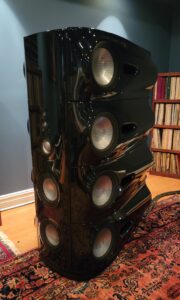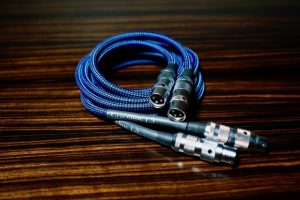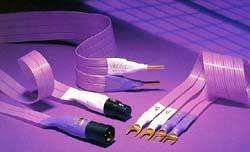The Persistence of Myth
If you've followed this hobby long enough, you've no doubt heard the oft-repeated barb that "all audio cables sound the same." In my estimation there is no more misleading or unsubstantiated audio shibboleth, one embraced widely by legions of the "all components sound the same brigade," than this misguided trope. Sadly, despite gallons of ink spilled on this topic—and mounds of credible testimonials to the contrary—the myth persists.
On the other hand, if you spend time with audiophiles smart enough to listen with an open mind (and open ears), you will likely hear a different tale. Contrary to what the audio fringe would have you believe, careful listeners overwhelmingly back the proposition that audio cables from different firms do indeed sound different, and that cable quality matters. In my years as a reviewer, and even more spent listening carefully to a variety of systems as a non-reviewer, I can attest that both experienced and novice listeners often have little difficulty discerning audible differences when cable changes occur.
Qualifying those differences and expressing them in terms that others can appreciate is the real communications challenge. For the record, I am not saying that everyone will interpret and describe the sonic differences they observe in the same way. Nor will they assign the same quantitative or qualitative values to those perceived differences, although it often surprises me how often, in very broad terms, sensitive listeners hear things similarly. From an impressionistic perspective, what matters are the qualitative (and coarse quantitative) assessments each listener is prepared to make. My impression that a given cable tends to soften musical transients, in absolute terms, is no more and no less valid than the impressions of another listener that the same cable provides a better sense of musical flow and ease to the overall presentation, all other factors being equal. The take-away from all of this: neither impression is wrong. That is the essence of impressionistic listening and reviewing: the conclusions that a given listener or reviewer reaches are, of necessity, wholly individualistic.
Having said that, let me also note that over the years, I have heard some fine-sounding cables across the price and design spectrum. At the lower end of the price spectrum, cables from companies like Audiocadabra and Soundstring Technologies remain sonic references for what their respective designers can accomplish at a given price-point. If you can spare a bit more money, musically compelling cables from the likes of Silnote Audio and Clarus Cables are sure to tickle your musical fancy. Yet more cash buys you outrageously good über-expensive cables from brands like Kubala-Sosna, Stealth, and Master Build. Wires from each firm can deliver genuinely excellent sound in properly configured systems, but each line sounds as different from the other as do a pair of fine loudspeakers from different speaker designers.
By the same token, cables of the same type from the same manufacturer can also sound different from their brethren. Move up or down a given manufacturer's line, and you will, ideally, notice strong family similarities, but also discreet, and at times, not so discreet differences. As a rule of thumb, once you reach the point where you can no longer hear musically meaningful distinctions between a given cable designer's top-of-the line offerings and his / her next to top-of-the-line models, stop spending. If you can't hear a difference, don't pay for what someone else says you should be able to hear.
In short, audio cable quality and specific cable design choices can profoundly alter how one's reference system sounds, despite what the Internet's legions of Doubting Thomas stone-throwers would have us believe. They are more than welcome to feast on their wee diets of Home Depot-sourced, garage-cobbled runs, and marvel over the belief that their latest budget finds purportedly sound every bit as good as the pricey but gorgeously designed and even more gorgeous sounding Kubala-Sosna Sensation loom that I recently had in house, or the more affordable but almost as enticing Silnote Audio Poseidon Signature II Master Reference speaker cables that are the subject of this review, for that matter.
In response, I would tell these doubters the same thing I would have told Donald John as he clung to the belief that the current Speaker of the House was going to gift him 8 billion smackers to build his bloody wall: it ain't true, dog!
The Silnote Formula
In the here-and-now, the Silnote Poseidon Signature II Master Reference cable, a new entry in the Silnote line, one that incorporates designer Mark Williams' latest theories on loudspeaker cable composition, design, and geometry, gets you damn close to sonic nirvana for not a lot of do-re-me. Priced at a competitive, if not cheap, $3,095 for an 8-foot run (with spade or banana terminations—I chose bananas), the Poseidon Signature II sounds like it should cost a whole lot more. It represents a real challenge to pricier wires in the under $10K speaker cable sweepstakes. Your neurosurgeon audiophile pal who just dropped $100K on a loom of reference cables, and who insists that the $10-15K cable loom you just bought sounds like shit, should really spend some time listening to this very fine cable.
The Poseidon Signature II is one of several new Silnote designs introduced late last year. The Poseidon II is pretty much an all-new, ground-up product. It features new connectors, utilizes Ultra-Pure Copper conductors (totaling 7 gauge), and special shielding that delivers what designer Mark Williams describes as "blacker backgrounds and greater transparency." Physically, the cables are wrapped in a high-quality black sheathing (nylon and cotton, I presume), boast considerable but not cartoonish girth (no Amazonian python-sized wires here), and remarkable flexibility. Beautifully built, the Poseidon Signature II proved exceptionally easy to install in my audio system. I appreciate the fact that I can "loop" the cable into place like a garden hose without much effort. This makes the Poseidon cables easy to live with, even where clearance behind your prized amplifier is limited.
True story: I once bought a close-out, half-priced speaker cable from a widely-regarded cable maker that sounded just swell. Unfortunately, the cable was so ridiculously heavy, thick, and unwieldy that I had difficulty placing it in my system. The cable was also too heavy to use with stand-mount speakers. Unless the speakers were secured via pre-machined threads to heavy and inert metal stands, the weight of the cables would pull my monitor speakers off their stands. The sheer bulk of those pythons also bent the binding posts of a nicely-built solid state amplifier that I still own. So much for a speedy sale on Audiogon!
The Silnote Poseidon carries no such ownership downsides. It sounds much better than I remember the closeout pythons sounding, doesn't cost much more than those brutes, and should work in just about any audio system I can imagine. What's not to like?
The Power of Purity
If you are at all familiar with some of Silnote's upper-tier offerings, like the Orion-M1 and M2 Master Reference speaker cables (the Orion M2 is my current long-term reference speaker cable), and the equally stunning Orion-M1 Master Reference balanced interconnects, the Poseidon Signature II will strike familiar chords. It possesses the smoothness, top-flight linearity, and striking naturalness that I noted in my earlier Silnote review for Positive Feedback (HERE), along with the line's signature musicality.
But—and this may come as a bit of a surprise to those of you who count yourselves fans of Mark's work (it certainly came as a surprise to me)—the Poseidon also differs from the M2 cables I use as references (and from the M1 too, if memory serves, but to a far lesser degree) in subtle but musically important ways. To my ears, and in simplest terms, the Poseidon Signature II sounds a touch more open and boasts a tonal balance that is more dead-of-center focused than the M2, particularly in the upper octaves. By comparison, the M2 sounds ever so slightly dark, meaning not that it sounds closed in or overly polite on top, but rather that it is voiced from the bass-up. To my ears, and in my system, this gifts the M2 with a noticeably more midrange-y balance that equates to a somewhat richer tonal perspective than the Poseidon delivers.
In absolute musical terms, this lends the Poseidon a somewhat lighter-footed and seemingly quicker sounding responsiveness. By way of contrast, the M2, still a fantastic cable, sounds a bit fuller tonally, and sings with a slightly more relaxed voice in the system. Where the Poseidon sounds engagingly electric (meaning it punches with a bit more speed on hard transients), the M2 sounds a bit more carefree and unhurried.
With the Poseidon in tow, music's upper octaves sounded resolute and airy, the midrange life-like and holographic, and the bass impressively taut, deep, and palpably detailed. On a cut like "Domino" (from Polish trumpeter Tomaz Stanko's 1999 release From the Green Hill (ECM)), the Poseidon placed Stanko, John Surman, and the rest of the band in the center of my listening room as living, breathing, 3D replicas of real musicians, not 2-dimensional cut-outs. This piece will catch out as inferior any system unable to capture instrumental colors, low-level dynamic shadings, and upper-octave air realistically. The Poseidon passed this test convincingly, whether mated to an affordable but overachieving tube amp like Mastersound's superb little BoX integrated, Parasound's great all-rounder, the new HINT 6 integrated, or pricier reference-caliber solid-state gear like the Mola Mola amp / preamp combo I currently have in-house (reviews all forthcoming).
The Poseidon speaker cables also excelled with a variety of speaker types. They worked a treat with the sealed-box Studio Electric M4 Monitors that I reviewed in Issue 100, and sang just as convincingly with the similarly priced Maggie 1.7is, my long-term reference in affordable panel loudspeakers. Adding another zero to the mix didn't alter the equation one bit. Von Schweikert Audio's Unifield 2 Mk III compacts, my reference in almost full-range compact speakers and amongst the most revealing speakers on the planet (reviewed in Issue 93), never caught the Poseidon cables short of breath dynamically, or tonally out of focus.
Substituting analogue for top-flight digital sources didn't alter the overall equation either. Chad Kassem's stellar reissue of the Sibelius: Symphony No. 5 and Karelia Suite (RCA/Decca-Analogue Productions) LP highlighted in unflinching terms what the Poseidon cables got right. Here, the Roanoke, Virginia sleepers delivered unexpectedly large doses of the air, openness, speed, transparency, and slam that one routinely hears with cost-no-object cables, but rarely gets with models that reside in the Poseidon's more down-to-earth neighborhood.
As well as they performed with my current Silnote mini-loom (balanced interconnects and speaker cables), the Poseidon also worked a treat with the mighty Kubala-Sosna "head to tail" Sensation cable loom (meaning power cables, interconnects and digital wires), suggesting their remarkable sonic malleability. That the Poseidon speaker cables were not outclassed in this august company says a hell of a lot about the value that Silnote delivers.
Parting Impressions
With its heightened transparency to sources, particularly amplifiers, its natural tonal balance, robust dynamic expressiveness, and unflappable naturalism, the Poseidon manages to cross the threshold that separates very good high-end performance from pure greatness. If you are in the market for a top-flight speaker cable in the $2500-5000 price range, I cannot recommend the newest Silnote highly enough. While it did fall a bit short of the absolute standard set by the more than 2x as expensive Kubala-Sosna Sensation speaker cables, especially the Sensation's stunning dynamic ease, center-of-the-earth low bass extension, and preternatural quietude, the Silnote's remarkable tonal purity, speed, superb articulation, and unflinching naturalness make it a real contender. I'm seriously considering purchasing a pair in bi-wire configuration to mate with my VSA Unifield 2 Mk III references. I was that impressed with its performance.
Enthusiastically recommended for audition!
Poseidon Signature II Master Reference Speaker Cable
Retail: $3095 for a 2.5-meter run (banana or spade terminations)
Silnote Audio










































